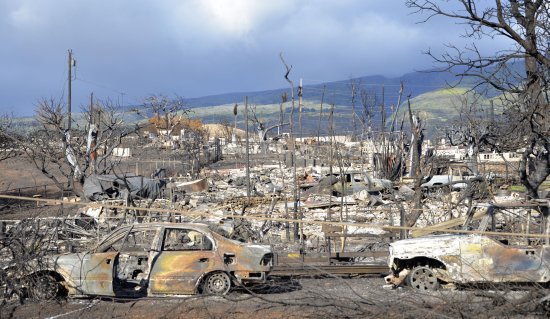
More blazes break out where wild land and urban areas overlap.
More than 30 square miles and 130 structures have been put to the torch in southern California as a wildfire fed by Santa Ana winds enters its third day, raging across Ventura County. It’s just one of a staggering 7,473 wildland fires the state has experienced this year. But Californians are not remotely alone in suffering this type of disaster.
Approximately 1.2 billion other people live uncomfortably close to a natural tinderbox, as human development around the world bumps up against fuel-rich wilderness. When those areas are added up, you get a 750,000-square-mile hot zone known as a wildland-urban interface (WUI). That’s the conclusion of a new study published in Science Advances, which used NASA satellite data to track the explosive growth of the WUI from 2000 to 2020. The research, led by geographic scientist Yonxuan Guo of the Chinese Academy of Sciences in Beijing, determined that the global reach of the WUI increased by 15% from 2000 to 2010, and then leapt by 85% from 2010 to 2020, leading to a dramatic increase in wildfires across the 1.44% of the planet’s continental surface that this hot zone represents.
[time-brightcove not-tgx=”true”]The three countries that saw the greatest expansion in wildland-urban overlap were the U.S., Nigeria, and China. But it was China that was the greatest among equals, accounting for 95.97% of all WUI expansion in the 2010 to 2020 window, due to the explosive growth of its cities and bustling commuter towns. Overall, temperate North America expanded its WUI footprint by 24.8% over the 20-year period; for central Asia the number was 21%, and for Europe 10.3%.
“The increase in WUI was primarily driven by the unprecedented expansion of global urbanization,” the authors wrote, “contributing an additional 589,914 square kilometers [227,727 sq. mi.] of WUI.”
While every continent except Antarctica experienced increased coverage of its wildland-urban interface over the course of the study period, there were still great swaths of terrain in areas where few humans live that remained untouched, especially in Northern Canada, the Australian deserts, the Sahara Desert, and Greenland.
The observations that formed the basis of the report were made by NASA’s Moderate Resolution Imaging Spectroradiometer (MODIS) instruments aboard the space agency’s Terra and Aqua satellites. Orbiting at an altitude of 438 miles, the spacecraft’s robotic eyes were nonetheless able to squint down to a resolution of just 99-ft. patches of ground—fine detail from so high a remove.
The problem zones the investigators observed did not occur at the fringes of the WUI, where the ground is predominantly urban on the one hand or wild on the other. That’s because in those areas, ignition sources like cigarette butts, campfires, or downed power wires tend not to come in contact with fuel sources like dry leaves, branches, and other kindling. Rather the danger occurs where 1,300-ft. bands of wildland overlap 650-ft. bands of urban or suburban development. When wilderness in those areas is put to the torch, the danger can spread far and fast—as demonstrated by the 2023 wildfire in Lahaina, Maui, which was caused by a downed powerline, destroying more than 80% of the town’s structures and killing 102 people; and the 2018 Camp Fire, in Paradise, Calif., also caused by a downed power line, which killed 85 people and destroyed nearly 19,000 structures. Even blazes that are relatively contained can do a lot of widespread damage, with smoke inhalation causing respiratory injury more than 600 miles from the ignition source.
The flames themselves don’t reach as far as the smoke does, but they do spread—an average of 1.25 to 5.5 miles from their origin within the WUI, the researchers found. Worldwide, the MODIS data showed, those high-risk zones experienced a total 1,500 fires per year. At greater distances, communities benefit from fragmentation, as highways, streets, and parking lots separate developments into parcels with paved fire breaks surrounding them. Blazes that do reach these areas are often more quickly extinguished since the extensive paved roadways make it easier to speed firefighting equipment where it’s needed.
The commingling of urban and wildland areas is too extensive to disentangle at this point, and Guo and his colleagues are under no illusions that one study will persuade developers to reverse two decades of planned growth. But the increase in wildfires over those same two decades will, they hope, at least persuade officials to make more robust firefighting assets available within the WUIs to contain future Lahaina- or Camp-scale fires before they can spread.
As Guo said in a statement that accompanied the release of the study: “Governments in countries that have experienced large increases in the WUI since 2000, such as eastern China, the United States, and Nigeria, should use more policy tools and allocate more resources to WUI areas.”